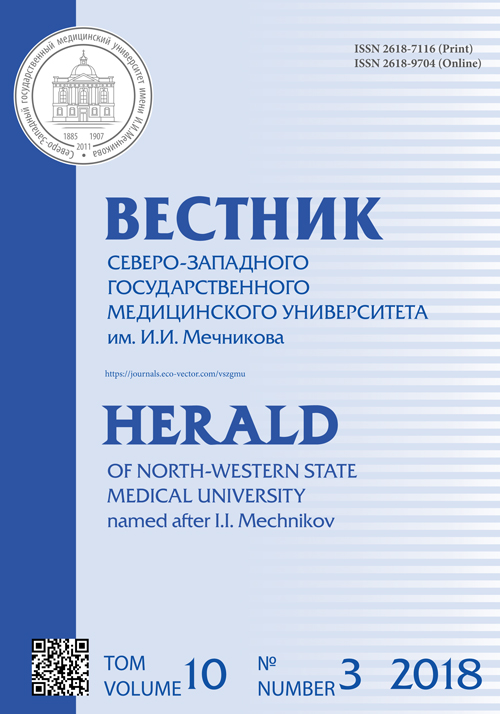Electroencephalographic monitoring in the intensive care unit
- Authors: Aleksandrov M.V.1, Aleksandrova T.V.2, Povaliukhina E.S.1
-
Affiliations:
- Polenov Russian Research Institute of Neurosurgery (the branch of Almazov National Medical Research Centre)
- Saint Petersburg I.I. Dzhanelidze Research Institute of Emergency Medicine
- Issue: Vol 10, No 3 (2018)
- Pages: 81-90
- Section: Diagnostic issues
- URL: https://journals.rcsi.science/vszgmu/article/view/10234
- DOI: https://doi.org/10.17816/mechnikov201810381-90
- ID: 10234
Cite item
Full Text
Abstract
EEG in the intensive care unit in critically ill patients can be provisionally allocated to a special type of research — EEG of critical states. The article deals with the methodological features of EEG performance in the intensive care, as well as general patterns of EEG changes in patients in coma. The analysis of the patterns of the EEG in intensive care unit is described. Parameters of responsiveness of the central nervous system are given. An algorithm for describing epileptiform changes is presented. The criteria for the diagnosis of nonconvulsive status epilepticus in unconscious patients are discussed, as well as a prognosis of the outcome of a long unconscious state in the presence of epileptiform changes in the EEG. Data on the parameters of periodic patterns are collected, their description and diagnostic criteria are given. The role and possibilities of EEG in the diagnosis of brain death are considered.
Full Text
##article.viewOnOriginalSite##About the authors
Mikhail V. Aleksandrov
Polenov Russian Research Institute of Neurosurgery (the branch of Almazov National Medical Research Centre)
Author for correspondence.
Email: mdoktor@yandex.ru
ORCID iD: 0000-0002-9935-3249
доктор медицинских наук, профессор, руководитель НИО клинической нейрофизиологии и эпилептологии
Russian Federation, Saint-PetersburgTatiana V. Aleksandrova
Saint Petersburg I.I. Dzhanelidze Research Institute of Emergency Medicine
Email: tata-al@yandex.ru
кандидат медицинских наук, заведующая отделением клинической нейрофизиологии
3, Budapeshtskaya street, Saint-Petersburg, 192242Ekaterina S. Povaliukhina
Polenov Russian Research Institute of Neurosurgery (the branch of Almazov National Medical Research Centre)
Email: katrinkassiopeya@gmail.com
врач функциональной диагностики, отделение клинической нейрофизиологии
Saint-PetersburgReferences
- Александров М.В., Иванов Л.Б., Улитин А.Ю., и др. Общая электроэнцефалография. – СПб.: Стратегия будущего, 2017. – 145 с. [Aleksandrov MV, Ivanov LB, Ulitin AYu, et al. Obshchaya elektroentsefalografiya. Saint Petersburg: Strategiya budushchego; 2017. 145 p. (In Russ.)]
- Шарова Е.В., Новикова М.Р., Куликов М.А. Компенсаторные реакции головного мозга при остром стволовом повреждении. – М.: Синтег, 2009. – 220 с. [Sharova EV, Novikova MR, Kulikov MA. Kompensatornye reak tsii golovnogo mozga pri ostrom stvolovom povrezhdenii. Moscow: Sinteg; 2009. 220 p. (In Russ.)]
- Арутюнян А.В., Александров М.В., Кузнецова Л.А., и др. Прогностичность фармакологического тестирования ЭЭГ при вегетативном состоянии в исходе тяжелого отравления // Функциональная диагностика. – 2013. – № 4. – С. 25–29. [Arutyunyan AV, Aleksandrov MV, Kuznetsova LA, et al. Prognostichnost’ farmakologicheskogo testirovaniya EEG pri vegetativnom so stoyanii v iskhode tyazhelogo otravleniya. Funktsional’naya diagnostika. 2013;(4):25-29. (In Russ.)]
- Lytaev S, Vasilyev S, Arutunyan A. The Predictability of Pharm-EEG in Patients with Long Unconscious Status. In: Fondations of Augmented Cognition. Springer; 2014. P. 288-295. doi: 10.1007/978-3-319-07527-3.
- Белкин А.А., Зислин Б.Д., Аврамченко А.А., и др. Синдром острой церебральной недостаточности как концепция нейрореаниматологии // Анестезиол. и реаниматол. – 2008. – № 2. – С. 4–8. [Belkin AA, Zislin BD, Avramchenko AA, et al. Sindrom ostroi tserebral’noi nedostatochnosti kak kontseptsiya neiroreanimatologii. Anesteziol. i reanimatol. 2008;(2):4-8. (In Russ.)]
- Кондратьева Е.А., Яковенко И.В. Вегетативное состояние: этиология, патогенез, диагностика и лечение. – М.: Медицина, 2014. – 361 с. [Kondrat’eva EA, Yakovenko IV. Vegetativnoe sostoyanie: etiologiya, pato genez, diagnostika i lechenie. Moscow: Meditsina; 2014. 361 p. (In Russ.)]
- Куценко С.А. Основы токсикологии: научно-методическое издание. – СПб.: Фолиант, 2004. – 720 с. [Ku tsenko SA. Osnovy toksikologii: nauchno-metodi cheskoe izdanie. Saint Petesburg: Foliant; 2004. 720 p.
- (In Russ.)]
- Полушин Ю.С., Александров М.В., Васильев С.А., и др. Роль холинергических механизмов в формировании исхода вегетативного состояния при экзо токсической коме // Вестник анестезиологии и реаниматологии. – 2012. – № 6. – С. 24–29. [Polushin YuS, Aleksandrov MV, Vasil’ev SA, et al. Rol’ kholinergicheskikh mekhanizmov v formirovanii iskhoda vegetativnogo sostoyaniya pri ekzotoksicheskoi kome. Vestnik anesteziologii i reanimatologii. 2012;(6):24-29.
- (In Russ.)]
- Sutter R, Kaplan PW. Electroencephalographic criteria for nonconvulsive status epilepticus: Synopsis and comprehensive survey. Epilepsia. 2012;53(Suppl. 3):1-51. doi: 10.1111/j.1528-1167.2012.03593.x.
- Sutter R, Kaplan PW. The neurophysiologic types of nonconvulsive status epilepticus: EEG patterns of different phenotypes. Epilepsia. 2013;54(Suppl. 6):23-27. doi: 10.1111/epi.12269.
- Hirsch LJ, La Roche SM, Gaspard N, et al. American Clinical Neurophysiology Society’s Standardized Critical Care EEG Terminology: 2012 version. J Clin Neurophysiol. 2013;30:1-27. doi: 10.1097/wnp.0b013e3182784729.
- Leitinger M, Beniczky S, Rohracher A, et al. Salzburg Consensus Criteria for Non-Convulsive Status Epilepticus — approach to clinical application. Epilepsy & Behavior. 2015;49:158-163. doi: 10.1016/j.yebeh.2015.05.007.
- Young B, Jordan K, Doig G. An assessment of nonconvulsive seizures in the intensive care unit using continuous EEG monitoring: an investigation of variables associated with mortality. Neurology. 1996;47:83-89. doi: 10.1212/wnl.47.1.83.
- Litt B, Wityk RJ, Hertz SH, et al. Nonconvulsive status epilepticus in the critically ill elderly. Epilepsia. 1998;39:1194-1202. doi: 10.1111/j.1528-1157.1998.tb01311.x.
- Treiman DM, Meyers PD, Walton NY, et al. A comparison of four treatments for generalized convulsive status epilepticus. Veterans Affairs Status Epilepticus Cooperative Study Group. N Engl J Med. 1998;339:792-8. doi: 10.1385/1-59259-945-1:127.
- Scholtes FB, Renier WO, Meinardi H. Generalized convulsive status epilepticus: causes, therapy, and outcome in 346 patients. Epilepsia. 1994;35(5):1104-12. doi: 10.1111/j.1528-1157.1994.tb02562.x.
- Shneker BF, Fountain NB. Assessment of acute morbi dity and mortality in nonconvulsive status epilepticus. Neurology. 2003;61(8):1066-1073. doi: 10.1212/01.wnl.0000082653.40257.0.
- Punia V, Bena J, Krishnan B, et al. New onset epilepsy among patients with periodic discharges on conti nuous electroencephalographic monitoring. Epilepsia. 2018;59:1612-1620. doi: 10.1111/epi.14509.
Supplementary files












